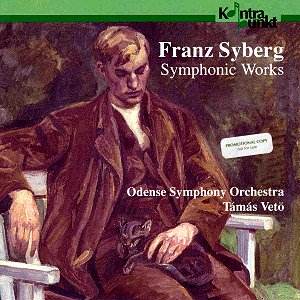Syberg
was educated in Germany - mainly at Leipzig. His output is small
in number and even so his short life was punctuated with long
musical silences firstly between 1934 and 1938 and then from 1940
until his death of heart failure in 1955. The latter period coincided
with his domestic commitments. He married in 1939 and supplemented
his small income as an organist with fruit growing and bee keeping.
His
music had dropped from sight until the Musikhøst90 in Odense
in 1990 when a selection of major works were interspersed with
those of the main celebrant, Poul Ruders. The press reception
was excellent hence the present CD. Despite the references to
Schoenberg, Hindemith and Stravinsky it is Nielsen who is to the
fore; here - unmistakably so. Listen, for example, to the woodwind
Elysium of the later stages of the Sinfonietta (an early
work) at 21.30. He has surely learnt from Nielsenís Helios
Overture and the Fifth and Sixth Symphonies. He is especially
inventive with percussion as the closing pages witness. The stately,
austere and probing Adagio for strings was written
after his triumphant homecoming from the 1938 London ISCM. This
is strongly though not academically contrapuntal and subdued with
three themes interacting each with the other in a way that is
no stranger to emotion - perhaps rather Bergian but certainly
emotional (2.18). There is no Nielsen in this.
The
three movement Symphony was written for a competition run
by the Royal Orchestra of Denmark. Holmboe gained first prize
with Syberg second. The Symphony was premiered on 19 January 1940
and was performed many times after this. Again Nielsen is not
really an issue in this work except in the violin susurration
at the end of the adagio molto. If anything this shows
the hand of Hindemith perhaps from Mathis der Maler or
Harmonie der Welt. The liner note writer claims the voice
of Stravinsky as well but frankly I cannot detect it. The work
was highly rated by Niels Viggo Bentzon who praised it above the
symphonies of Nielsen. It is a positive piece full of optimism
but not at all superficial. It rises to a superbly sanguine emphasis
at 08.50 towards the end of the first movement. The finale has
the jerky optimism of the jazzy finale of Walter Piston's Second
Symphony. The work ends in a triumph of blaringly positive high
spirits.
It
is a pity again that the individual movements are not separately
tracked rather than with index points.
The
detailed and extensive notes are by Bertel Krarup.
You
would do well to snap up this rare collection. Syberg is not a
second Nielsen. He writes well in an idiom influenced by the great
Carl but decisively coloured by the symphonic Hindemith.
Rob
Barnett
